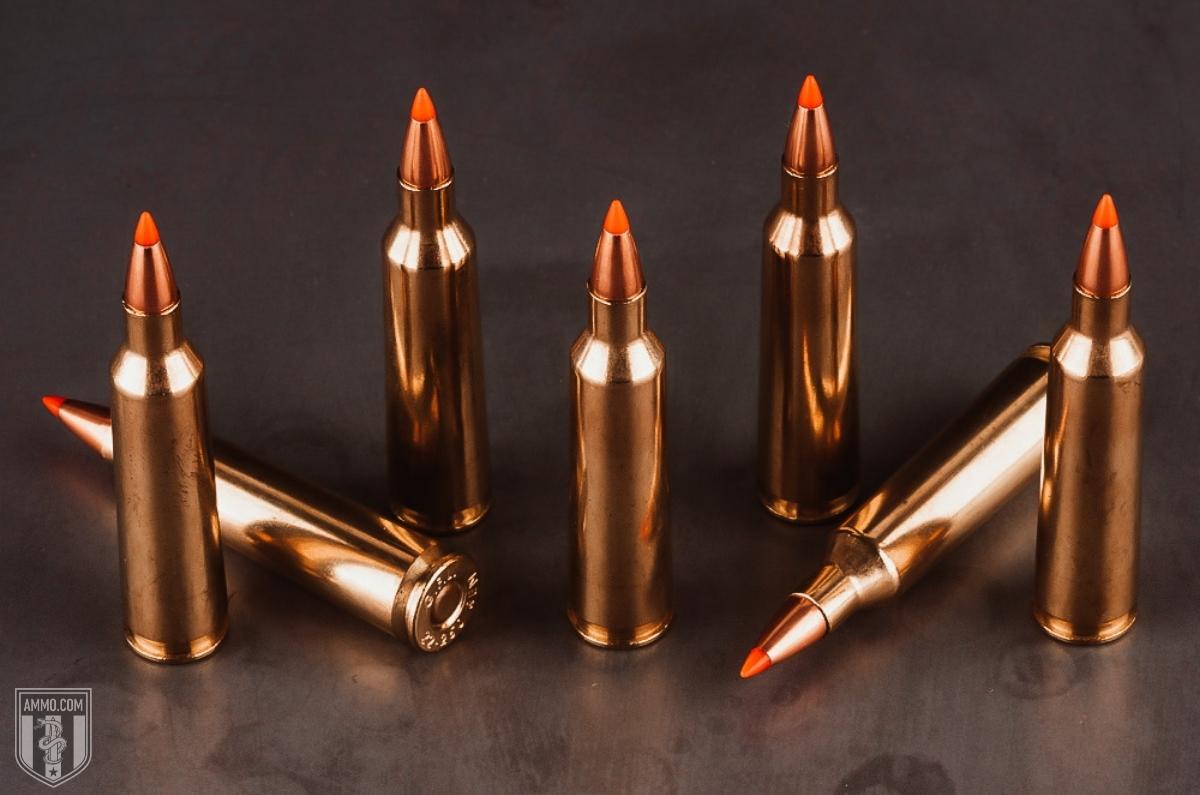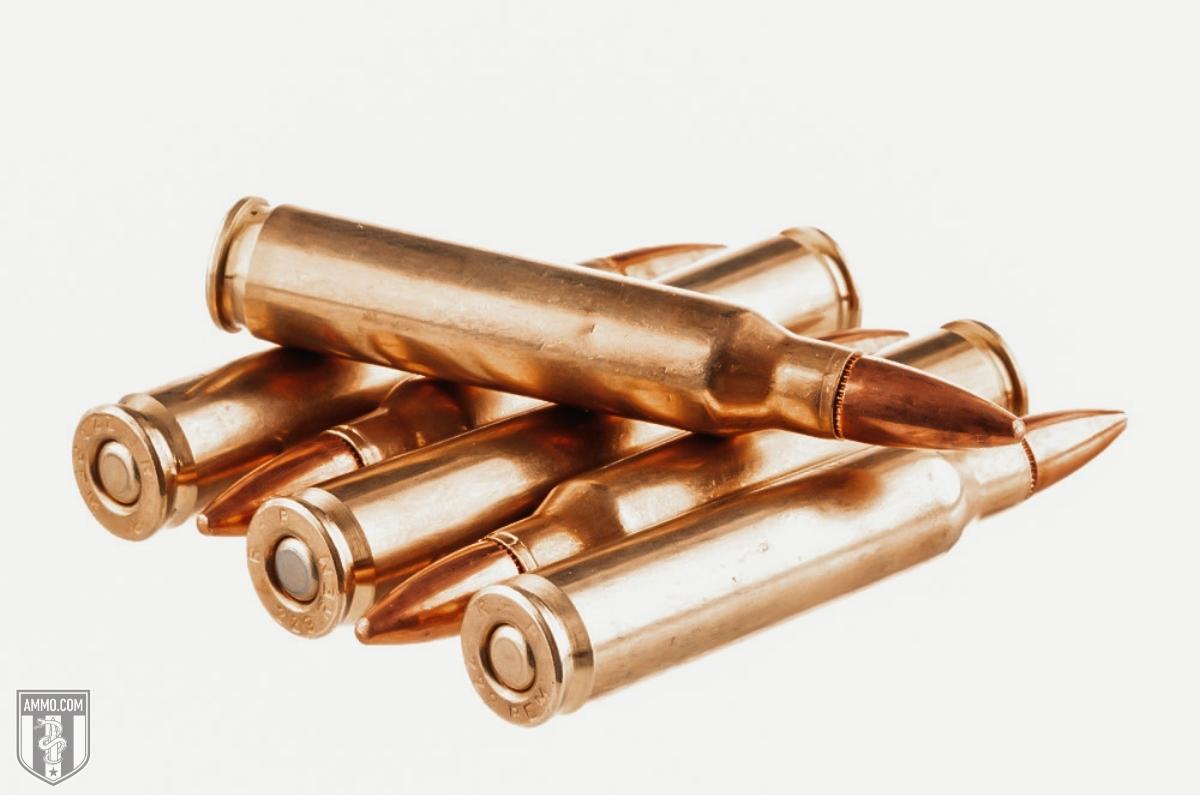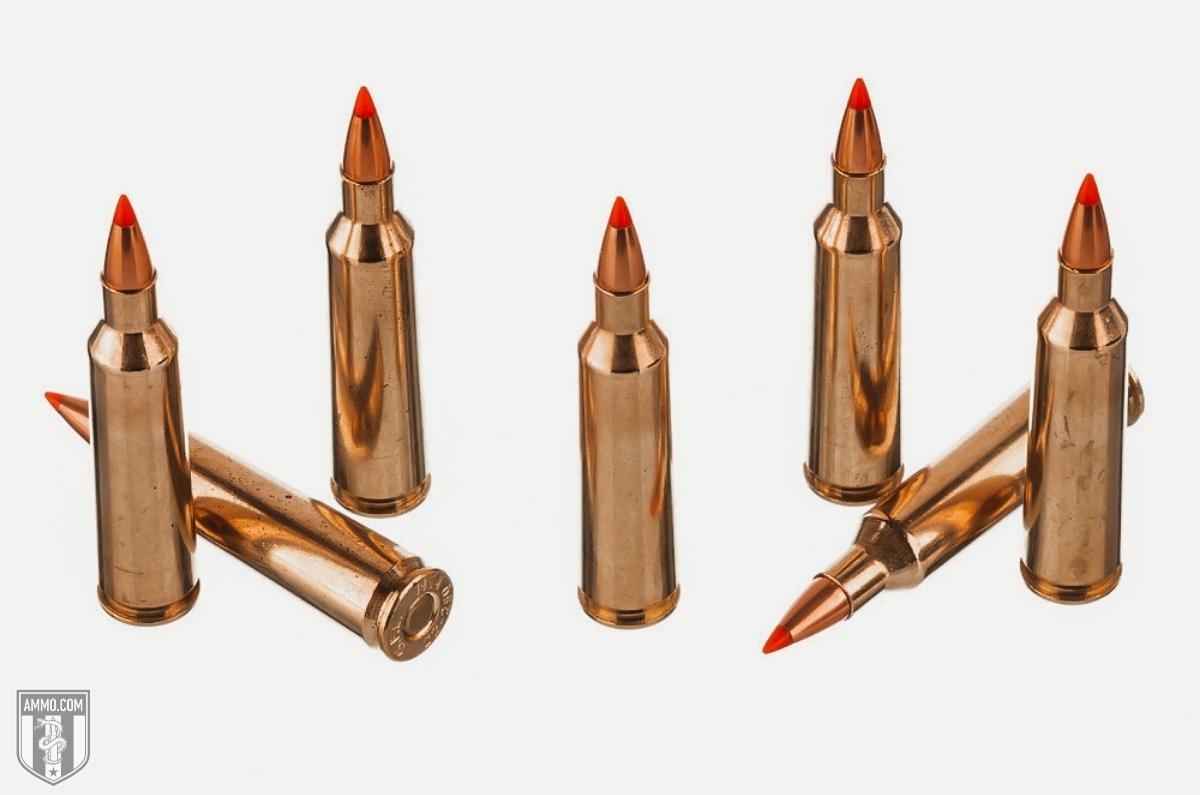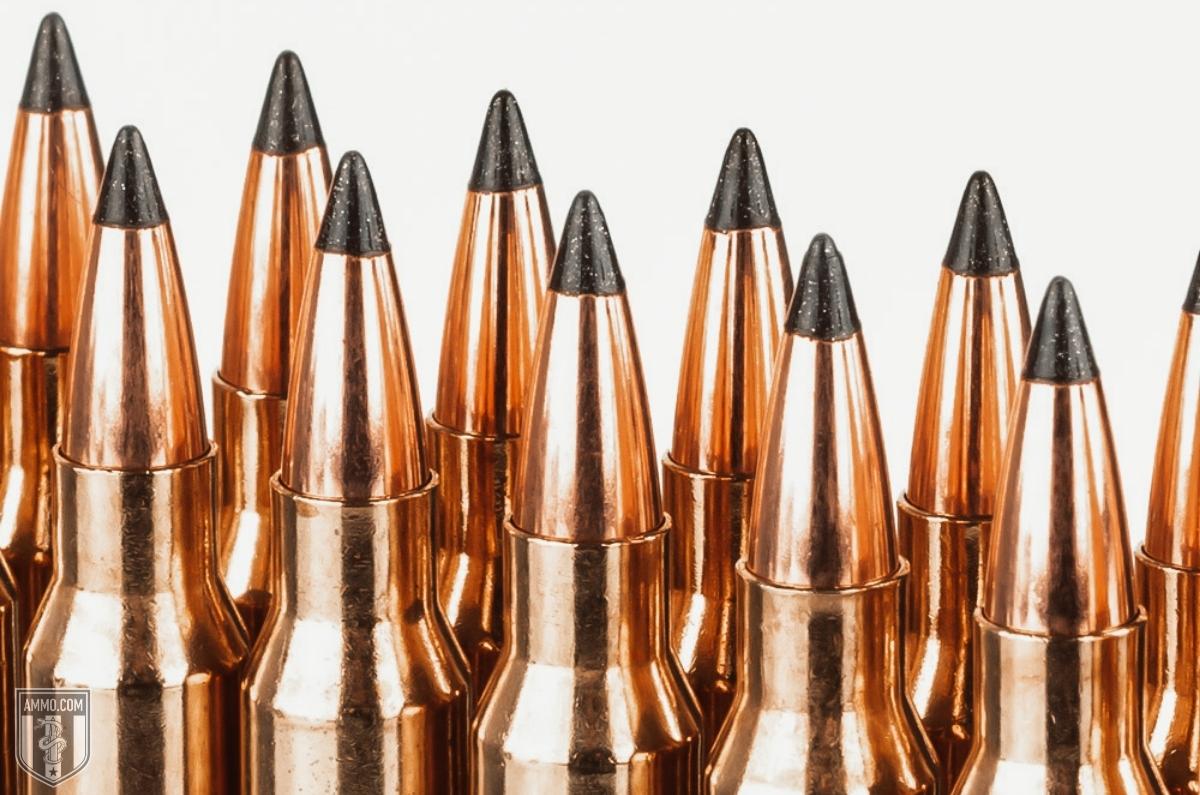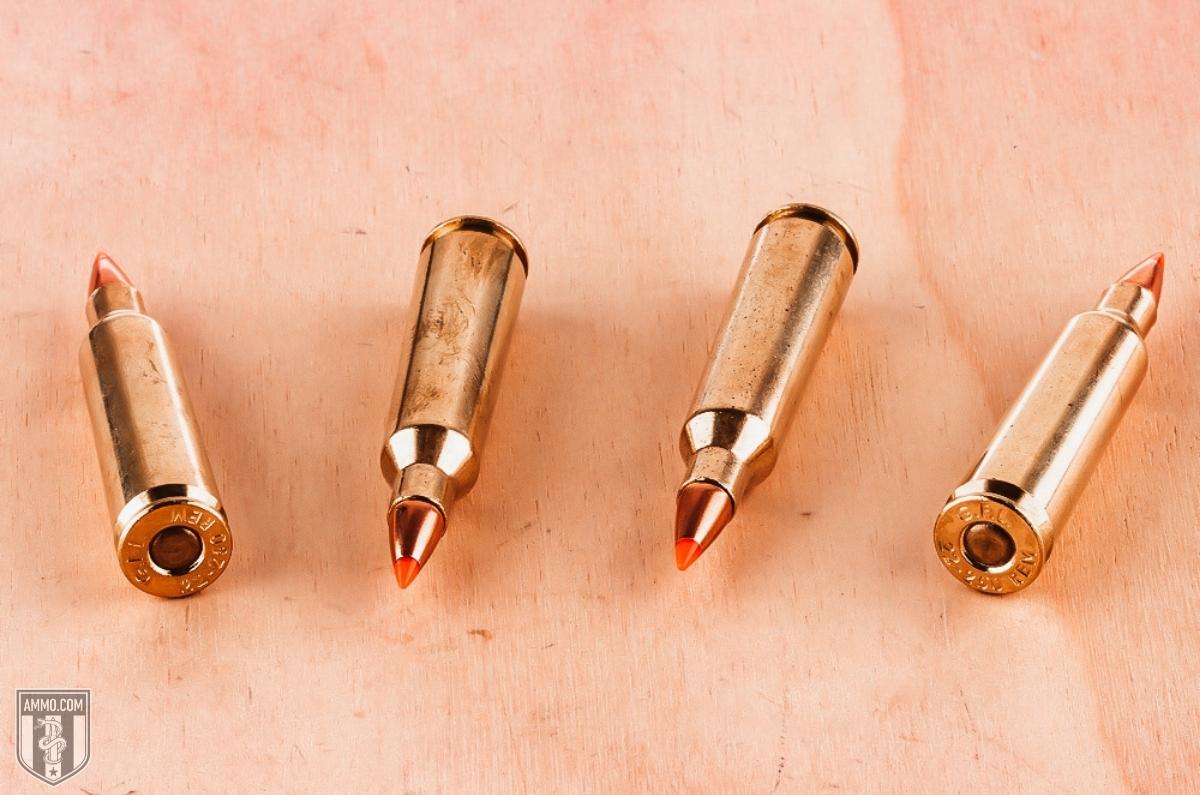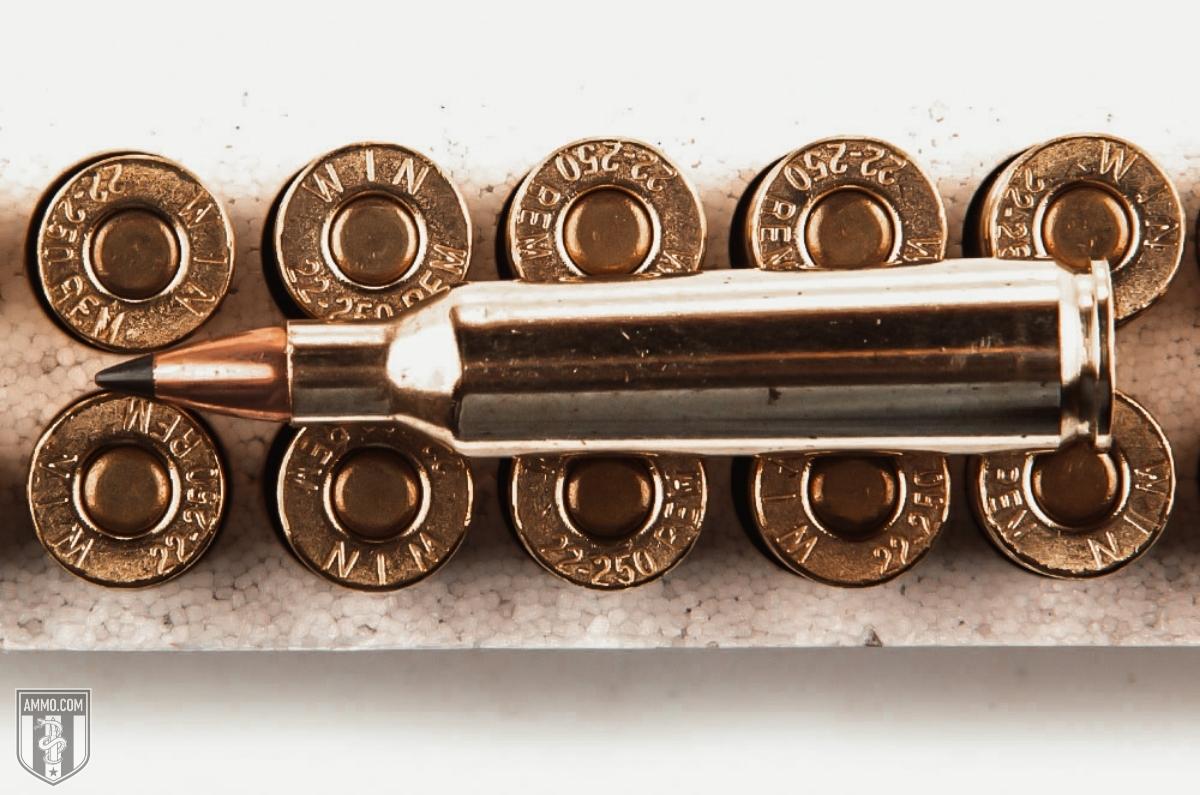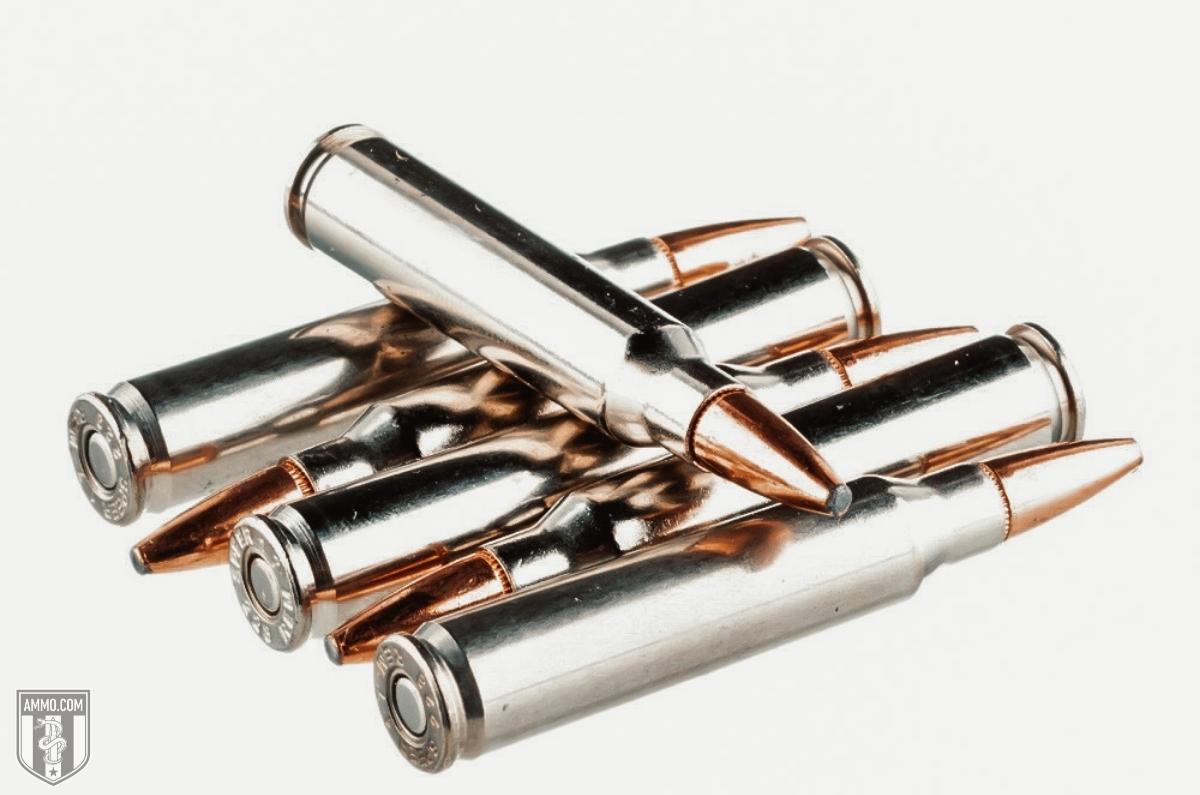22-250 vs 223: Varmint Hunting Versatility for Coyotes to Prairie Dogs
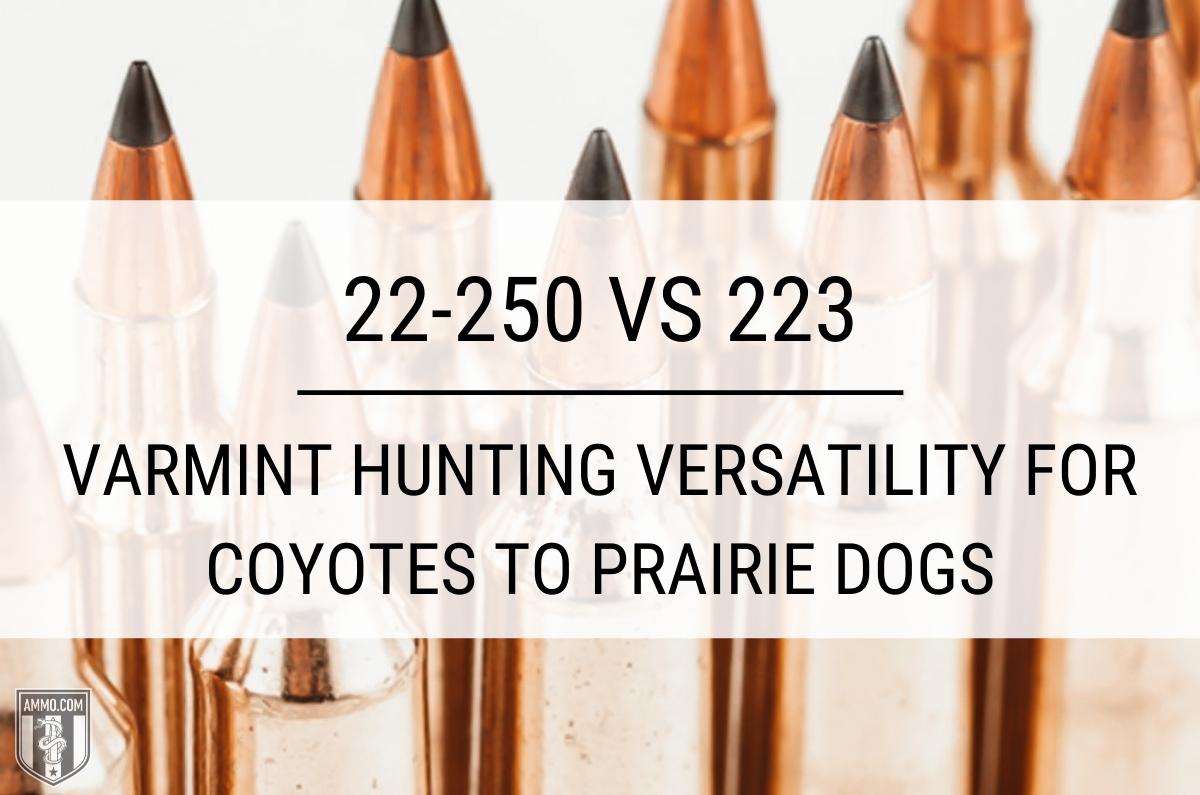 When the topic of varmint hunting or controlling coyotes are brought up on shooting forums or gun store counters, it doesn’t take long for the debate over 223 vs 22-250 to come boiling to the surface. As two of the most popular centerfire rifle cartridges for dispatching furry nuisances at long range, you cannot go wrong with either for your next hunting rifle.
When the topic of varmint hunting or controlling coyotes are brought up on shooting forums or gun store counters, it doesn’t take long for the debate over 223 vs 22-250 to come boiling to the surface. As two of the most popular centerfire rifle cartridges for dispatching furry nuisances at long range, you cannot go wrong with either for your next hunting rifle.
Although the 223 Rem and 22-250 fire the same diameter bullets, each cartridge has its own unique advantages and disadvantages that need to be considered when selecting it for your varmint ammo of choice.
The 22 250 Remington was built with varmint hunting in mind and has been long regarded as one of the best options for long range varmint shooting due to its high velocity and flat trajectory.
However, the 223 Remington is one of the most popular centerfire rifle cartridges on the market, as it is the frontline battle rifle caliber for the US military and NATO and has become popularized by the widespread success of the AR-15 sporting rifle.
In this article, we will compare two of the most popular varmint cartridges on the market today so that you know which is best for your new semi-auto or bolt action rifle.
What is the Difference Between 22-250 and 223?
The difference between the 22-250 and 223 Rem is that the 22-250 has a higher muzzle velocity than the 223 Rem. Both rifle cartridges fire the same bullet diameter, but as the 22-250 has a greater case capacity, its bullets will be fired at higher velocity.
A Note on Nomenclature
Please note that within this article we will refer to the 223 Remington (223 Rem) and the 5.56x45mm NATO round interchangeably. There are differences between the two that you can read about in our article, .223 vs 5.56.
In short, a 223 Rem can safely be fired from a rifle or handgun chambered in 5.56, however the opposite is not true.
Cartridge Specs
When evaluating two centerfire rifle cartridges tuned for high velocity long range shooting, it’s a good idea to analyze the cartridge specs to gain more knowledge of each.
When comparing the cartridge case of the 22-250 vs 223, one of the most striking differences is the width of each case. The 22-250 is considerably “fatter” than the 223 Remington with a base diameter of 0.47” for 22-250 compared to 0.376” for 223.
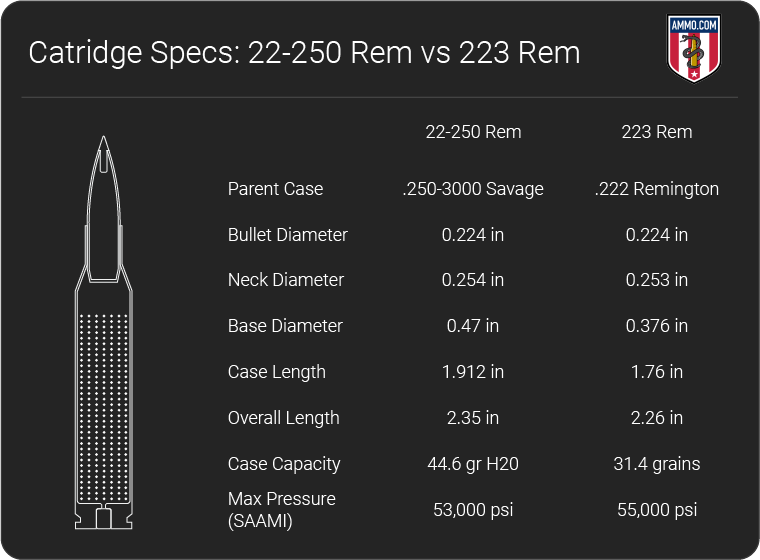
This directly correlates to the case capacity of each cartridge, as the 22-250 has a distinct advantage over the 223 (44.6 gr vs 31.4 gr, respectively). As both rifle cartridges fire the same 0.224” diameter bullet, it’s safe to say that we should expect the 22-250 to have higher muzzle velocities than the 223 Remington.
The final difference between the 22-250 vs 223 is their case length. The 22-250 has a longer case at 1.912” compared to 1.76” for 223. This in turn correlates to a longer overall length for the 22-250 of 2.35” compared to 2.26” for 223.
The 22-250 is simply a bigger cartridge, it can hold more powder than the 223 while both fire the same diameter bullets.
Recoil
Neither the 223 nor 22-250 is known for having heavy recoil, and this is one of their greatest advantages for small game hunting. As they both have low recoil, it’s unlikely that new shooters will develop a recoil anticipation flinch.
Although recoil for both cartridges is low, the 223 Rem technically has less free recoil as it measures in around 4 ft-lbs compared to 6.7 ft-lbs for 22-250.
Although this is mathematically a 67% difference, only the most recoil sensitive shooters will be able to feel much of a difference between the two.
For most shooters, recoil should not be a major deciding factor between 22-250 vs 223, but for those who have extreme recoil sensitivity the 223 Remington is the clear choice.
Muzzle Velocity and Kinetic Energy
The 22 250 Remington is known for being an absolute speed demon, and for many years it held the title as the fastest round on the market. It has since been eclipsed by the 220 Swift and the 204 Ruger, but the 22-250 is still a hotrod of a cartridge.
This is not to say that the 223 Rem is any slouch when it comes to speed, as it is quite a quick round, the 22-250 is just faster mostly due to its increased case capacity.
For comparison, we will consider a 55-grain bullet for both cartridges, more specifically the Hornady V-MAX as this is an incredibly popular varmint bullet.
Don't forget to check out our Hornady 22-250 ammo page for more ammo options.
The 22-250 is screaming out of the muzzle at an impressive 3,680 fps with 1,654 ft-lbs of muzzle energy.In comparison, the 223 Remington has a muzzle velocity of 3,240 fps and muzzle energy of 1,282 ft-lbs.
Although the numbers for the 223 Rem are impressive, the 22-250 is faster and hits harder with the same bullet weight.
Trajectory
Trajectory is how we quantify a bullet’s flight path as it travels downrange measured in inches of bullet drop.
Obviously, a flatter shooting cartridge is preferred for long-range shooting, as a shooter will require fewer adjustments to their optics to compensate for bullet drop. Having a flatter trajectory also means that a cartridge will be more forgiving of ranging mistakes.
The incredibly high muzzle velocity of the 22-250 has given it a well-known reputation for having a very flat trajectory on par with the 6.5 Creedmoor.
Comparing the same 55-grain bullet from the previous section and assuming a 100 yard zero, the 22-250 will have experienced -38” of bullet drop at 500 yards compared to -53” for the 223 Rem.
The 22-250 will generally always have a flatter trajectory than the 223 Rem when comparing similar bullet weights and this makes the 22-250 the better choice for longer range shots.
Ballistic Coefficient
Ballistic coefficient (BC) is a measure of how well a bullet resists wind drift and air resistance. Put another way, it’s a numeric representation of how aerodynamic a bullet is. A high BC is preferred as this means the bullet will buck the wind easier.
Generally, heavy bullets will have a higher BC as it takes more force to disrupt the flight of a heavier bullet than a lighter one. Ballistic coefficient varies from bullet to bullet based on design, weight, and other factors that are beyond the scope of this article.
As the 223 Remington and 22-250 fire the same 0.224” diameter bullets, there will be virtually zero difference in ballistic coefficient when comparing similar bullet weights.
However, as the 22-250 has more muzzle velocity, it will reach the target faster and suffer less wind drift compared to the 223. Assuming a 10 mph crosswind, the 22-250 will have experienced 29” of wind drift at 500 yards compared to 35” for 223. Even though the BC for the 55-grain V-MAX is the same for both cartridges (0.255), the 22-250 will be affected by the wind less.
In an apples-to-apples comparison with identical bullet weights and profiles the 22-250 will always come out on top in terms of wind drift. However, it’s important to note that the 223 Rem can fire heavier bullets than the 22-250 as 223 rifles typically have a faster barrel twist rate (more on this in another section of this article). Therefore, the 223 can stabilize higher BC bullets like the Sierra 77 grain open tip match (OTM) with a BC of 0.372 whereas the 22-250 is limited to bullets around 60 grains maximum.
Sectional Density
Sectional Density (SD) is the measure of how well a bullet penetrates a target. This is extremely important when hunting big and medium sized game, as you need a bullet that can punch through thick hide, bone, and sinew.
Sectional density is calculated by comparing the bullet weight and the bullet diameter. The higher the SD the deeper the bullet will penetrate into the target. This is a simplified view of penetration as there are other factors to consider, such as bullet expansion and velocity.
As the 223 Remington and 22-250 can fire the same bullets, their sectional density values will be identical. For example, the 55 gr V-MAX has a SD of 0.157 for both 223 and 22-250.
It is unlikely that any hunter will be able to detect any difference in penetration on small game, coyotes, and other varmints with either round.
Barrel Life and Twist Rate
Barrel twist rate is a term that is often thrown around in the shooting world but sometimes misunderstood.
When a bullet is fired, it travels down the barrel and begins to spin due to the rifling. This spin stabilizes the bullet in flight, increasing accuracy and consistency.
For rifle barrels, twist rate is expressed as a ratio of rotations per length of barrel. For example, a 1:7 twist barrel will cause a bullet to experience 1 full rotation per 7 inches of barrel length.
Typically, longer, heavier bullets require a faster twist barrel while lighter bullets work better in a slower twist barrel. This means that your barrels twist rate will directly impact which bullet weights your rifle will fire best.
For your standard 16-18” barreled AR-15 chambered in 223/5.56 NATO, you will generally find there are three different twist rates available: 1:9, 1:8, and 1:7. In comparison, 22-250 rifles are typically adorned with 22-24” barrels with a 1:12 or 1:14 twist rate.
This means that the 22-250 will excel at stabilizing lighter to middleweight bullets that are exceptional for small game whereas the 223 Rem can stabilize middle to heavier weight bullets that work well on small to medium sized game like coyotes.
Barrel life is a metric often thrown around on internet forums as a way to evaluate a rifle cartridge but is extremely difficult to quantify as there are several factors that go into determining how fast a barrel is “shot out.”
The biggest enemy of barrel life is heat. The more frequently a barrel gets heated to high levels, the faster the rifling will wear and the shorter your barrel life will be.
As the 22-250 has the higher case capacity, it should, in theory, have a shorter barrel life as the larger powder charge should wear on the barrel harder than a 223. However, most 22-250 shooters do not report their barrels becoming shot out. This is because the 22-250 is primarily fired from a bolt action rifle, and although rapid fire is possible, most bolt action shooters take their time between shots.
Therefore, barrel life should not be a major issue and its very likely that a 22-250 hunting rifle can be passed down from generation to generation.
Hunting
When considering a caliber for your new hunting rifle, it’s important to think about what game animals you intend to hunt.
When it comes to small game hunting, it’s hard to beat the 22-250. Its flat trajectory allows for longer range shots and its lighter bullets are extremely effective at humanely harvesting varmints while preserving the meat and hides.
The 223 Rem is also extremely effective on small game and has been utilized by varmint hunters since its release, the 22-250 is just slightly better.
For medium sized game like feral hogs and coyote hunting, the 223 would be a better option as you have access to heavier bullets. Something along the lines of a 60 gr Barnes TTSX or Nosler Ballistic tip will make short work of any coyotes that cross your path. As 223 Rem rifles typically have a faster twist rate than 22-250, the 223 rifle will stabilize these heavier bullets.
Many coyotes are felled each year with a 22-250 and it should not be overlooked as a potent coyote hunting caliber, the 223 just offers more versatility in this.
Although both rifle cartridges are excellent choices for small and medium game hunting, neither the 22-250 nor 223 should be utilized for big game as they lack the kinetic energy to ethically (and legally) harvest these game animals.
But what about whitetail deer hunting?
The topic of ethically and legally hunting whitetail with a 22-caliber cartridge has been discussed at length over campfires, at sporting good stores, and hunting forums. Anecdotal stories about survivors hunting whitetail with a rimfire like a 22 Hornet or .22 LR and successfully claiming a deer does not mean that it is ethical to do so or that a 223 or 22-250 would be a better option.
Although the 22-250 and 223 have the muzzle energy to ethically harvest a whitetail, they simply do not have the wounding capabilities of larger calibers such as the 308 Winchester or 6.5 Creedmoor. These larger calibers carry more kinetic energy and create larger wound channels that are considerably more effective at stopping large game.
As such, many states and provinces prohibit the use of 22-caliber bullets for deer hunting, requiring a minimum bullet diameter of 0.243”. Can you use a 223 or 22 250 for deer? If your state allows it, yes. Of the two I’d favor 223 as it allows for heavier bullets which will be more effective and harvesting the animal. However, as there are so many more powerful options on the market, I’d prefer something larger like a 308 or 30-06 for whitetail.
Ammo and Rifle Cost/Availability
When it comes to ammo cost and availability, the 223 Remington is the clear winner.
As the 223 Rem/5.56 NATO is a military cartridge currently in service, there is a plethora of surplus ammo available on the market that drives prices down. Furthermore, the widespread success of the AR-15 sporting rifle has catapulted the 223 to incredible heights of popularity.
Every major ammo manufacturer, like Hornady, Nosler, Sierra, Federal, PMC, Wolf, and Remington all have multiple factory loads for 223.
Even though wildcat loads for the 22-250 predate the round's standardization, it never reached the levels of success seen with the 223.
On average, cheap steel-cased 223 ammo can go as cheap as $0.40/round while premium hunting ammo typically costs $1.20/round on average.
Buying in bulk is always smart, make sure to check out our stock of 223 bulk ammo.
Comparatively, practice ammo for 22-250 starts around $1.60/round with premium ammo going for $2.20/round and up.
When it comes to rifles, most 22-250 shooters are limited to bolt action rifles. Although you can easily find bolt action rifles for 223, most shooters prefer the semi-auto AR-15. All major rifle manufacturers like Savage, Remington, Winchester, Weatherby, and Sako have offerings in both calibers.
You simply cannot beat the 223 Remington in terms of price and availability for ammo and rifles, as its widespread popularity has driven the price considerably lower than the 22-250.
Reloading
One way to reduce your overall cost per round is by handloading your own ammo. This helps offset the cost of factory ammo, especially for 22-250.
And if you like to reload, both the 223 Rem and 22-250 are excellent options as the share the same bullet diameter. This means you can buy your bullets in bulk and use them to reload for both rifle cartridges.
Handloading allows you to really tailor your rounds to your rifle(s) and reach the pinnacle of accuracy for both cartridges.
Virtually every bullet manufacturer, like Hornady, Sierra, and Nosler, have multiple offerings for 0.224” diameter bullets to really dial in your reloads.
In terms of brass, finding 223 cases is ridiculously easy. As it is a military caliber and currently in service, there are numerous vendors selling once-fired or factory new brass for relatively low prices. However, 22-250 brass is a bit more difficult to come by, so you should expect to pay a bit more for these cases than you would for 223.
Handloading for both cartridges is an excellent way to keep your shooting costs as low as possible, or to shoot more for the same price! Sounds like a win-win scenario if you ask me.
Ballistics: 223 vs 22-250
Our team here at Ammo.com has spent countless hours scouring the Internet to bring you extremely comprehensive ballistics tables for both calibers. Below are tables that compare bullet weight to muzzle velocity, kinetic energy, and trajectory for both 22-250 vs 223 Rem.
22-250 Ballistics
Note: This information comes from the manufacturer and is for informational purposes only. The actual ballistics obtained with your firearm can vary considerably from the advertised ballistics. Also, ballistics can vary from lot to lot with the same brand and type load.
| 22-250 Bullet WEIGHT | Muzzle VELOCITY (fps) | Muzzle ENERGY (ft. lbs.) | TRAJECTORY (in.) | |||||||||||
|---|---|---|---|---|---|---|---|---|---|---|---|---|---|---|
| Muzzle | 100 yds. | 200 yds. | 300 yds. | 400 yds. | Muzzle | 100 yds. | 200 yds. | 300 yds. | 400 yds. | 100 yds. | 200 yds. | 300 yds. | 400 yds. | |
| 35 Grain | 4450 | 3736 | 3128 | 2598 | 2125 | 1539 | 1085 | 761 | 524 | 351 | 6.5 | 0 | -4.1 | -13.4 |
| 40 Grain | 4000 | 3320 | 2720 | 2200 | 1740 | 1420 | 980 | 660 | 430 | 265 | 2 | 1.8 | -3 | -16 |
| 40 Grain | 4150 | 3553 | 3033 | 2570 | 2151 | 1530 | 1121 | 817 | 587 | 411 | 0.6 | 0 | -4.4 | -14.2 |
| 45 Grain Green | 4000 | 3293 | 2690 | 2159 | 1696 | 1598 | 1084 | 723 | 466 | 287 | 1.7 | 1.7 | -3.2 | -15.7 |
| 50 Grain | 3725 | 3264 | 2641 | 2455 | 2103 | 1540 | 1183 | 896 | 669 | 491 | 0.89 | 0 | -5.23 | -16.3 |
| 52 Grain | 3680 | 3137 | 2656 | 2222 | 1832 | 1654 | 1201 | 861 | 603 | 410 | 2 | 1.3 | -4 | -17 |
| 55 Grain | 3680 | 3137 | 2656 | 2222 | 1832 | 1654 | 1201 | 861 | 603 | 410 | 2 | 1.3 | -4 | -17 |
| 60 Grain | 3600 | 3195 | 2826 | 2485 | 2169 | 1727 | 1360 | 1064 | 823 | 627 | 2 | 2 | -2.4 | -12.3 |
| 64 Grain | 3425 | 2988 | 2591 | 2228 | 1897 | 1667 | 1269 | 954 | 705 | 511 | 1.2 | 0 | -6.4 | -20 |
.223 Rem Ballistics
Note: This information comes from the manufacturer and is for informational purposes only. The actual ballistics obtained with your firearm can vary considerably from the advertised ballistics. Also, ballistics can vary from lot to lot with the same brand and type load.
| 223 Bullet WEIGHT | Muzzle VELOCITY (fps) | Muzzle ENERGY (ft. lbs.) | TRAJECTORY (in.) | |||||||||||
|---|---|---|---|---|---|---|---|---|---|---|---|---|---|---|
| Muzzle | 100 yds. | 200 yds. | 300 yds. | 400 yds. | Muzzle | 100 yds. | 200 yds. | 300 yds. | 400 yds. | 100 yds. | 200 yds. | 300 yds. | 400 yds. | |
| 35 Grain | 3750 | 3206 | 2725 | 2291 | 1899 | 1092 | 799 | 577 | 408 | 280 | 1 | 0 | -5.7 | -18.1 |
| 35 Grain | 4000 | 3353 | 2796 | 2302 | 1861 | 1243 | 874 | 607 | 412 | 269 | 0.8 | 0 | -5.3 | -17.3 |
| 40 Grain | 3650 | 3010 | 2450 | 1950 | 1530 | 1185 | 805 | 535 | 340 | 265 | 2 | 1 | -6 | -22 |
| 40 Grain | 3800 | 3305 | 2845 | 2424 | 2044 | 1282 | 970 | 719 | 522 | 371 | 0.84 | 0 | -5.34 | -16.6 |
| 45 Grain Green | 3550 | 2911 | 2355 | 1865 | 1451 | 1259 | 847 | 554 | 347 | 210 | 2.5 | 2.3 | -4.3 | -21.1 |
| 50 Grain | 3300 | 2874 | 2484 | 2130 | 1809 | 1209 | 917 | 685 | 504 | 363 | 1.37 | 0 | -7.05 | -21.8 |
| 52 Grain | 3330 | 2882 | 2477 | 2106 | 1770 | 1305 | 978 | 722 | 522 | 369 | 2 | 0.6 | -6.5 | -21.5 |
| 53 Grain | 3330 | 2882 | 2477 | 2106 | 1770 | 1305 | 978 | 722 | 522 | 369 | 2 | 0.6 | -6.5 | -21.5 |
| 55 Grain Green | 3240 | 2747 | 2304 | 1905 | 1554 | 1282 | 921 | 648 | 443 | 295 | 1.9 | 0 | -8.5 | -26.7 |
| 55 Grain | 3240 | 2748 | 2305 | 1906 | 1556 | 1282 | 922 | 649 | 444 | 296 | 2 | -0.2 | -9 | -27 |
| 60 Grain | 3100 | 2712 | 2355 | 2026 | 1726 | 1280 | 979 | 739 | 547 | 397 | 2 | 0.2 | -8 | -24.7 |
| 62 Grain | 3000 | 2700 | 2410 | 2150 | 1900 | 1240 | 1000 | 800 | 635 | 495 | 1.6 | 0 | -7.7 | -22.8 |
| 64 Grain | 2750 | 2368 | 2018 | 1701 | 1427 | 1074 | 796 | 578 | 411 | 289 | 2.4 | 0 | -11 | -34.1 |
| 64 Grain | 3020 | 2621 | 2256 | 1920 | 1619 | 1296 | 977 | 723 | 524 | 373 | 2 | -0.2 | -9.3 | -23 |
| 64 Grain | 3020 | 2621 | 2256 | 1920 | 1619 | 1296 | 977 | 723 | 524 | 373 | 2 | -0.2 | -9.3 | -23 |
| 69 Grain | 3000 | 2720 | 2460 | 2210 | 1980 | 1380 | 1135 | 925 | 750 | 600 | 2 | 0.8 | -5.8 | -17.5 |
| 75 Grain | 2790 | 2554 | 2330 | 2119 | 1926 | 1296 | 1086 | 904 | 747 | 617 | 2.37 | 0 | -8.75 | -25.1 |
| 75 Grain | 2790 | 2562 | 2345 | 2139 | 1943 | 1296 | 1093 | 916 | 762 | 629 | 1.5 | 0 | -8.2 | -24.1 |
| 75 Grain | 2790 | 2562 | 2345 | 2139 | 1943 | 1296 | 1093 | 916 | 762 | 629 | 1.5 | 0 | -8.2 | -24.1 |
| 75 Grain Super Match | 2930 | 2694 | 2470 | 2257 | 2055 | 1429 | 1209 | 1016 | 848 | 703 | 1.2 | 0 | -6.9 | -20.7 |
| 77 Grain | 2750 | 2584 | 2354 | 2169 | 1992 | 1293 | 1110 | 948 | 804 | 679 | 1.93 | 0 | -8.2 | -23.8 |
A Brief History of 22-250 Remington
Developed in 1937, the 22-250 Remington began its life as a wildcat cartridge. Gunsmiths of the era created the cartridge by necking down the .250-3000 Savage to accept 22 caliber bullets.
Capable of pushing a 55-grain bullet at a muzzle velocity of nearly 3,800 FPS, the 22-250 has the second fastest muzzle velocity of any 22 caliber centerfire cartridge, only bested by the 220 Swift.
During its lifetime, the 22-250 Rem has also been known as the 22 Varminter and 22 Wotkyns Original Swift.
Although the new cartridge showed incredible promise, it lived in wildcat obscurity for over 20 years until 1963 when Browning offered the cartridge in its Browning High Power bolt-action rifle. This was an incredibly bold move by Browning as it was offering a rifle chambered in a cartridge that the company itself did not produce ammo for.
Seeing the potential in the cartridge, Remington adopted the 22 Varminter in 1965 by chambering it in their Remington 700 and 40 XB rifles and redubbed the cartridge the “22-250 Remington.” Along with the new rifles, Remington also offered their own line of the new 22-250 ammo thereby beginning the widespread acceptance of the 22-250 as a varmint hunting staple.
Due to its slower barrel twist rate, the 22-250 excels at firing lighter 22 caliber projectiles between 30-60 grains with a ridiculously flat trajectory and accuracy at unsuspecting prairie dogs at ranges under 1,000 yards.
To read more about the 22-250, check out the full history of the cartridge on our 22-250 history page.
If you’d like to learn more about how the 22-250 compares to other calibers, check out our article comparing 22-250 vs 224 Valkyrie.
A Brief History of 223 Remington
Development of the 223 Remington rifle round began in 1957 and the final design was submitted by Remington Arms to the Sporting Arms and Ammunition Manufacturers' Institute (SAAMI) in 1962.
The development of the 223 Remington cartridge was a joint operation organized by the U.S. Continental Army Command between Fairchild Industries, Remington Arms, and Eugene Stoner of Armalite, using the 222 Remington as a parent cartridge.
The 222 Remington case was elongated 0.06” and the neck was shortened. These changes allowed for the new 223 Remington ammunition to have a 20% larger powder charge than its progenitor.
Eugene Stoner was the primary inventor of the AR-10 rifle (chambered in 7.62x51 NATO), which he was invited to scale down to accommodate the new .223 Rem cartridge.
The resulting rifle that the military accepted was the M16, the civilian version being the AR-15. Since adoption, the AR-15 carbine has become the most popular sporting rifle in US history.
With its lightweight and low recoil, the M16 is an ideal platform for full auto fire and the ammo is considerably lighter than its 308 Winchester counterpart. This allows soldiers to carry more ammo into battle for the same weight, meaning they can stay in the fight longer without impeding their mobility.
Since then, the M16 and the shorter barrel length M4 Carbine have become a ubiquitous symbol of American military prowess across the globe.
The original 223 Rem mil-spec ammo that the U.S. Military adopted was named M193, which fired a 55 gr full metal jacket (FMJ) bullet at a muzzle velocity of 3240 FPS with a muzzle energy of 1282 foot-pounds.
The new 223 Remington cartridge had sufficient long range capability out to 500 yards while maintaining accuracy and offers bullet weights between 35 and 77 grains.
The 223 Rem was released to the civilian market one year before adoption by the U.S. Army, and varmint hunters enjoyed the new cartridge’s low recoil, extreme accuracy, and lower pressure.
It was not long before all the major firearm manufacturers offered semi-auto and bolt action rifle in the new 223 Remington cartridge.
If you’d like to learn more about how the 223 Rem compares to other calibers, check out the articles below:
Final Shots: 22-250 vs 223
The 223 and 22-250 are two excellent centerfire cartridges that offer shooters versatility and low recoil for pest control or long range shooting.
The 22 250 Remington has a long-established track record of being a superb varmint round and is ballistically superior to the 223 in virtually every category. With a flatter trajectory and higher muzzle energy, the 22-250 hits harder and can shoot further than the 223.
However, the 22-250 has its limitations as well with the slower 1:12 and 1:14 twist rate barrels being the primary issue as this limits the bullet weight these rifles can stabilize. Furthermore, the overall cost per round and recoil is higher for the 22-250.
On the other hand, the 223 has a lower overall cost per round and can be found virtually anywhere ammo is sold as it is the de facto chambering for the AR-15 platform. The 223 is ideal for high volume shooting and its relatively light recoil makes it a joy to shoot all day at the range.
The faster 1:7 twist rate barrels used for 223 Rem make it more suitable for heavier bullets that are favored for hunting medium sized game like coyotes and hogs. The AR-15 is also an ideal platform for dispatching these midsized varmints, as the semi-automatic nature of the rifle lends itself to low recoil and faster follow-up shots.
Selecting which cartridge is best for your new hunting rifle depends primarily on what you plan to hunt. If you enjoy taking longer range shots on small game like prairie dogs, you’ll be hard pressed to find any fault in the 22-250. However, if you prefer high volume shooting, something more cost effective and semi-auto capable, then the 223 should be on your short list.
Regardless of which cartridge you choose, make sure to get all of your ammo here on Ammo.com and I’ll see you out on the range!
Ammo Comparisons
- .308 vs 5.56
- 6.5 Creedmoor vs .308
- .300 Blackout vs .308
- .300 Win Mag vs .308
- .243 vs .308
- .308 vs .30-06
- 7mm-08 vs .308
- .270 vs .308
- 7.62x39 vs .308
- .223 vs .308
- .338 Lapua vs .308
- .380 ACP vs 9mm
- .223 vs 5.56
- .300 Blackout vs 5.56
- 9mm vs 45 ACP
- 9mm vs 40 S&W
- .357 SIG vs 9mm
- 10mm vs 9mm
- 9mm vs 9mm Luger
- .243 vs .270
- .300 Win Mag vs .30-06
- .270 vs .30-06
- .40 vs .45
- 38 Special vs 357
- 9mm vs 40 vs 45
- 5.56 vs 7.62x39
- 338 Lapua vs .30-06
- .30-30 vs .30-06
- 300 PRC vs 338 Lapua
- .30-06 vs 7mm
- 300 Win Mag vs 338 Lapua
- 300 PRC vs 300 Win Mag
- 300 WSM vs 300 Win Mag
- 338 Win Mag vs 338 Lapua
- 12 Gauge vs 20 Gauge
- 10mm vs 357 Mag
- .30-30 vs 7.62x39
- 224 Valkyrie vs 22-250
- 17 HMR vs 22 Mag
- 7.62x39 vs .300 Blackout
- 45 ACP vs 45 Auto
- 45-70 vs 30-30
- 300 Blackout vs 223
- 357 Magnum vs 9mm
- 350 Legend vs 300 Blackout
- 224 Valkyrie vs 223
- 45 ACP vs 38 Super
- 6.5 Grendel vs .308
- 17 HMR vs 22 LR
- 10 Gauge vs 12 Gauge
- 22-250 vs 223
- 45 Colt vs 45 ACP
- 350 Legend vs 30-30
- 5.7x28 vs 223
- 5.7 vs 9mm
- 5.56 vs 5.7
- 22 vs 9mm
- Buckshot vs Birdshot
- 450 Bushmaster vs 308
- 450 Bushmaster vs 223
- Buckshot vs Slug
- 6.5 Grendel vs 5.56 vs 223
- 6mm ARC vs 6.5 Grendel
- 44 vs 45
- 458 SOCOM vs 5.56
- 357 vs 44
- 32 ACP vs 380
- 300 Win Mag vs 338 Win Mag vs 338 Lapua Mag
- 450 Bushmaster vs 458 SOCOM vs 50 Beowulf
- 6mm Creedmoor vs 6.5 Creedmoor
- TMJ vs FMJ
- 44 Special Vs 44 Magnum
- 45 90 vs 45 70
- 6.8 Western vs 6.8 SPC
- 50 Beowulf vs 50 BMG
- 26 Nosler vs 6.5 PRC
- 28 Gauge vs 410
- 6.8 SPC vs 5.56
- 6.8 SPC vs 6.5 Grendel
- 6.8 Western vs 7mm Rem Mag vs .28 Nosler
- 6.8 Western vs 6.5 Creedmoor
- 22 Hornet vs 223
- 6.8 Western vs 6.5 PRC
- .410 vs 12 Gauge
- .410 vs 20 Gauge
- 22 LR vs 22 Mag
- 6mm ARC vs 243
- 7mm-08 vs 270
- 243 vs 6.5 Creedmoor
- Nickel vs Brass Casing
- 204 Ruger vs 223
- 50 Beowulf vs 5.56
- 260 Remington vs 6.5 Creedmoor
- 6mm Remington vs 243
- 28 Nosler vs 300 PRC
- 50 Beowulf vs 50 AE
- 22 Nosler vs 22-250
- 450 Marlin vs 45-70
- 300 Win Mag vs 300 Norma
- 458 SOCOM vs 300 Blackout
- 38-55 vs 45-70
- 22 Hornet vs 22 LR
- 300 Norma vs 338 Lapua
- 338 Lapua vs 50 BMG
- 28 Nosler vs 300 Win Mag
- 28 Nosler vs 6.5 Creedmoor
- 204 vs 22-250
- 458 SOCOM vs 45 70
- 44 40 vs 45 70
- 6.8 SPC vs 6.5 Creedmoor
- 450 Bushmaster vs 30-06
- 7mm Rem Mag vs 300 Win Mag
- 30 Carbine vs 223
- 25-06 vs 30-06
- 26 Nosler vs 28 Nosler
- 16ga vs 12ga
- 30 06 vs 7.62 x54R
- 9mm Makarov vs 9mm Luger
- 350 Legend vs 223
- 30 Carbine vs 5.56
- 6.5x55 vs 6.5 Creedmoor
- 6.5 Creedmoor vs 270 vs 25-06
- M193 vs M855
- 450 Bushmaster vs 458 SOCOM
- 6.5 Grendel vs 6.5 Creedmoor
- 350 Legend vs 5.56
- .277 Fury vs 6.8 SPC
- 277 Fury vs 300 Win Mag
- 10mm vs .45 ACP
- 277 Fury vs 223
- 6.8 SPC vs 300 Blackout
- 6.5 PRC vs 6.5 Creedmoor
- 277 Fury vs 308
- 277 Fury vs 6.5 Creedmoor
- 350 Legend vs 450 Bushmaster
- 277 Fury Vs 5.56 NATO
- 10mm vs 40S&W
- 32 ACP vs 9mm
- 32 Special vs 9mm
- 8.6 Blackout vs 300 Blackout
- 30 Super Carry vs. 9mm
- 5.56 vs 9mm
- .50 Action Express vs 9mm
- 7.62x25 vs. 9mm
- 10mm vs 44 Magnum
- 300 Blackout vs 300 Win Mag
- 6.5 Grendel vs 300 Blackout
- 460 Rowland vs 10mm
- 300 RUM vs 300 PRC
- 300 Norma vs 300 PRC
- 45 GAP vs 45 ACP
- 7mm PRC vs 300 Win Mag
- 300 PRC vs 6.5 Creedmoor
- 300 PRC vs 308
- 357 SIG vs 357 Mag
- 7.62x39 vs 7.62x51
- 243 Win vs 223 Rem
- 30 Nosler vs 300 PRC
- 6.5 Creedmoor vs. 30-06 Springfield
- 450 S&W vs. 44 Magnum
- 6.5 Creedmoor vs. 300 Win Mag
- 454 Cassull vs. 45-70 Govt
- 454 Cassull vs. 44 Mag
- 7.62x54r vs. 308 Winchester
- 22 ARC vs. 223 Rem
- Subsonic vs. Supersonic Ammo
